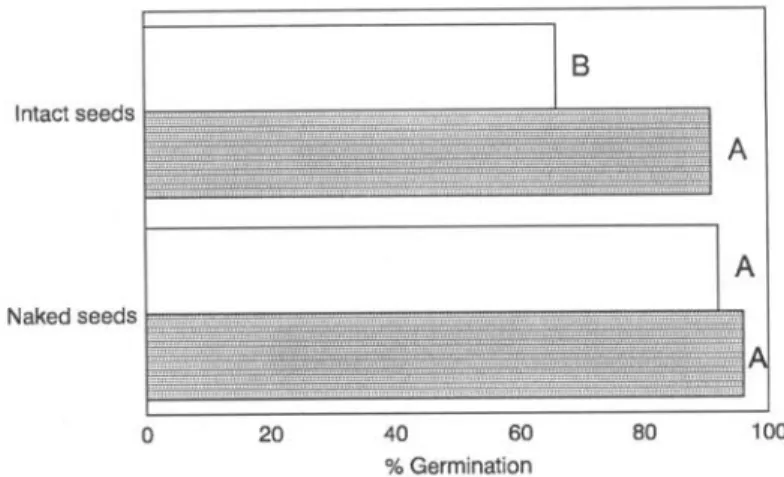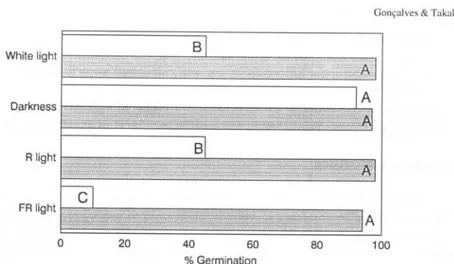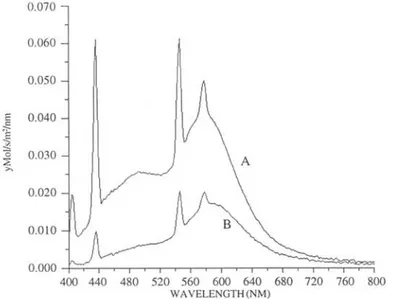Acta bot. bras. 1 1 ( 1 ): 1997
THE ROLE OF THE SEED COAT IN THE LIGHT
SENSITIVITY IN
RAPHANUS SATIVUS
L.
CV. REDONDO
GIGANTE SEEDS
55
Maura Lúcia Costa Gonçalvesl
Massanori Takaki I
Recebido em 20/11/96. Aceito em 13/6/97
RESUMO - (O papel do tegumento na sensibilidade à luz em sementes de Raphanus sativus L. cv. redondo gigante). O papel do tegumento sobre a sensibilidade à luz em sementes de Raphanus sativus L. cv. redondo gigante foi analisado por testes de germinação de sementes intactas e nuas. A luz vermelho-extremo inibiu fortemente a germinação, enquanto as luzes branca e vermelha apresentaram baixa inibição. Por outro lado, sementes nuas não apresentaram sensibilidade à luz, com alta porcentagem de germinação tanto na luz como no escuro. Entretanto, a incubação das sementes nuas em condições de estresse em solução de polietilenoglicol a -0,6MPa, resultou em inibição na luz, como observadas em sementes intactas. A análise da luz transmitida pelo tegumen-to das sementes indicou que a luz filtrada apresenta o mesmo fotegumen-toequilíbrio teórico do fitegumen-tocromo obtido na luz branca, com um decréscimo em apenas 33% da irradiância que atinge o embrião.
Palavras-chave: germinação de sementes, Raphanus sativus, tegumento, fitocromo
ABSTRACT - (The role ofthe seed coat in the light sensivity in Raplwnus sativusL. cv . redondo gigante seeds). The role ofthe seed coat in the light sensitivity ofseeds of Raphanus sativus L. cv. redondo gigante was analysed by germination tests of intact and naked seeds. Far-red light caused high inhibition of seed germination, while under white and red lights low inhibition was found. Naked seeds presented no light sensitivity with high percentage germination under light and darkness. However, incubation of naked seeds in -0.6MPa polyethylene glycol solution resulted in light inhibition as observed in intact seeds . The analysis of the seed coat transmitted light indicated that the filtered light presented the same photoequilibrium of phytochrome when compared to the white light, with a decrease of only 33% in the light irradiance which reaches the embryo.
Key words: seed germination, Raphanus sativus, seed coat, phytochrome
56 Gonçalves & Takaki Introduction
The germination of seeds of Raphanus sativus is controIled by light under water
stress conditions (MacDonough 1967) and Ladeira et aI. (1987) have proposed that
the phytochrome is used by plants as a transducer of soil water potential. Freitas & Takaki (1992) have proposed the involvement of phytochrome in the control of germination in light insensitive seed of R. sativus under water stress conditions, therefore observing the fluence dependent inhibition of seed germination by far red (FR), red (R) and white light, with highest inhibition by FR light. Barbarini & Takaki
(1989), working with Phaseolus vulgaris, observed high light sensivity after osmotic
treatment, indicating changes in the mode of phytochrome action. Takaki & Toledo (1991), working with seeds of Oryza sativa, also observed that scarified seeds germinated both in light and darkness under water stress conditions.
The role of the seed coat in the control of seed germination was analysed in several weedy species by Felippe & Polo (1983), demonstrating that light sensiti vity is lost after scarification in both positive and negative photoblastic seeds. Cardoso &
Felippe (1988), working with negative photoblastic seeds of Cucumis anguria, have
proposed that after analysis oflight transmitted by seed coat, enrichment with FR light is responsible for white light inhibition of seed germination. However, the spectrum analysis of the seed coat transmitted light indicated that the photoequilibrium of 0.68 is maintained by fluorescent white light. The same effect was reported by Leite &
Takaki (1994) in seeds of Piptadenia gonoacantha in which decrease in 6% of
photoequilibrium of phytochrome in the region of the embryo was observed. In the present work we describe the role of the seed coat in the light sensitivity of seeds of Raphanus sativus L. cv. redondo gigante.
Material and methods
Seeds of Raphanus sativus L. cv. redondo gigante used in the present work were
purchased in a local seed shop. The germination condition was the same as described by Ladeira et aI. (1987), where four batches of thirty seeds were put on two layers of imbibed filter papers with water or polyethylene glycol6000 (PEG) solution in 90mm Petri dishes. The water potential of PEG solutions were calculated according to
Michel (1983). The light conditions were also the same as described by Ladeiraet ai.
(1987). Darkness conditions were obtained by wrapping the dishes with two layers of aluminum foi!. All the germination tests were carried out at 25°C. Scarification of seeds was carried out by remotion of the seed coat by hand in 6 hours water imbibed seed. Seeds were considered as germinated when showed a root of 2mm at least, and dark germinated seeds were counted under dim green safe light (Kendrick & Frankland 1969). Each experiment was repeated at least twice, with similar results.
The role of the seed coat in the light sensitivity in Raphanus sarivus cv. redondo gigante seeds 57
spectroradiometer (LI-COR, U.S.A.) positioned under fluorescent white light. The light spectra were analysed using the PC1800 software (LI-COR, USA). The theore-tical photoequilibrium of the phytochroPle was calculated using thefollowing equati-on: <p=O.87/(1+(O.295/Ç», where, <p=photoequilibrium of the phytochrome and Ç=irradiance at 655-665nmlirradiance at 725-735nm (Mancinelli 1994). The results were submitted to the Tukey test at 5% significance levei of arc sin--J%/lOO.
Results and discussion
Seeds of Raphanus sativus cv. redondo gigante germinate better under 25°C in
darkness than under fluorescent white light, but naked seeds germinated both under dark and white light (Fig. 1). This effect was reported by Felippe & Polo (1983) in photoblastic weedy seeds, where scarification resulted in germination under white light and darkness.
Intact seeds
Naked seeds
o
20 40 60 80 100% Germination
Figure 1. Effect of remotion of seed coat on the germination of Raphanus sativus L. cv. redondo gigante under white light Co) and darkness Cfil).
FR light caused high inhibition of germination of Raphanus sativus intact seeds
while R light had the same effect of white light. However, light treatment had no effect in naked seeds, with high germination rates (Fig. 2). Similar results were reported by Freitas & Takaki (1992) in light insensitive batch of cultivar redondo gigante after water stress.
58 Gonçalves & Taknki
White light
Darkness
R light
FR light
o
20 40 60 80 100% Germination
Figure 2. Effect oflight quality treatment on seed germination of Raphanus sativus L. cv . redondo gigante. Intact (o) and naked (l\) R= red and FR=far-red.
White light
Darkness
R light
FR light
o
20 40 60 80 100% Germination
Figure 3. Effect of incubation of intact (o) and naked (t:J) seeds of Raplzanus sativus L. cv . redondo gigante under -O.6MPa solution of PEG on seed germination under different light qualities .
The seed coat transmitted light analysis indicates that RlFR ratio is 3.34 while of the white fluorescent is 3.75. The theoretical photoequilibrium of phytochrome indicates that white light maintains 0.806 ofPfr while seed coat filtered light maintains 0.799 ofPfr. These results indicate that the seed coat did not change the light quality but only the light irradiance of 1.646 found in the fluorescent white light to 0.543W.m·2 of
The role of lhe seed COilt in lhe light sensitivit y in Rllp/llIllllS SlIlivlIS cv . redondo gigilnte seeds
E c:
;,-~
'5
~
"-0.070
0.060
0.050
0.040
0.030
0.020
0.010
0.000
l=~=---r-"'--'-~--'--r--T--r---.---'----:;:::~~~~
400 440 480 520 560 600 640 680 720 760 800
w A VELENGTH (NM)
59
Figure 4. Spectra ofwhite fluorescent light (A) and oftransmitted light by the seed coat of Raphanus safivlIs
L. CV. redondo gigante (8).
The ratio of spectrum of white light by spectrum of light transmitted the seed coat indicates that short wavelengths are transmitted more by the seed coat than the long wavelengths which are more active for phytochrome cyc1ing in the high irradian-ce response (Fig. 5) (Mancinelli 1994).
0.070
0.060
0.050
0.040
0.030
0.020
0.010
0.000 -t--r-.,.-..--.-,.---,,....,-.-.--r~-y-~-y-~-.--r-.,.-,....-,
400 440 480 520 560 600 640 680 720 760 800
w A VELENGTH (NM)
Figure 5. Spectrum ratio of the white fluorescent light and transmitted light by the seed coat of Raphanus
60 Gonçalves & Takaki
Finally, we have conc\uded that the Raphanus sativus seed coat has two functions as quantitative filter decreasing the light irradiance which reaches the embryo and resistance for the rupture of the seed coat by the embryo. Under both conditions the phytochrome is involved in the control of seed germination, the decrease in light irradiance by the seed coat induces low phytochrome cycling (Mancinelli 1994) and the resistance to expansion of the embryo presents the same effect of water stress condition which according to Ladeiraet ai. (1987) the phytochro-me is the pigphytochro-ment responsible for the monitoring the soil water status.
Acknowledgements
M.T. is supported by a CNPq research fellowship. We thank to Dr. Reinaldo Monteiro for the revision of the English manuscript. This work was supported in part by grants from CNPq, FUNDUNESP and FAPESP.
References
8arbarini, N.R. & Takaki, M. 1989. Osmotically induced high light sensitivity in seedling of Phaseo/us vu/garis. Biologia Plantarum 31: 227-229.
Cardoso, V.J.M. & Felippe, G.M. 1988. The action ofthe testa upon the germination ofseeds of Cucumis anguria L. Biologia Plantarum 30: 48-52.
Felippe, G.M. & Polo, M. 1983. Germinação de ervas invasoras: efeito de luz e escarificação. Revista Brasileira de Botânica 6: 55-60.
Freitas, N.P. & Takaki, M. 1992. Phytochrome controlled seed germination in light insensitive seeds of
Raphanus sativus L. cv. redondo gigante. Arquivos de Biologia e Tecnologia 35: 609-612. Kendrick, R.E. & Frankland, B. 1969 Photocontrol of germination in Amaranthus caudatus. Planta 85:
326-329.
Ladeira, A.M.; Guardia, M.C. & Takaki, M. 1987 Manipulation of seed germination in P/antago tomentosa Lam. and Raphanus sativus L. Seed Science and Technology 15: 55-63.
Leite, I.T.A. & Takaki, M. 1994 Análise da germinação de sementes de Piptadenia gonoacantha (Mart.) Macbr. (Leguminosae - Mimosoideae). Arquivos de Biologia e Tecnologia 37: 587-595. McDonough, W.T. 1967 Dormant and non dormant similar germination response when osmotically
inhibited. Nature 214: 1147-1148.
Mancinelli, A.L. 1994 The physiology of action. In: R.E. Kendrick & G.H.M. Kronenberg Ced.), Photo-morphogenesis in plants 2nd ed., p. 211-269, Kluwer Kluwer Academic Publishers, Dordrecht. Michel, B.E. 1983 Evaluation of the water potentials of solutions of polyethylene glycol 8000 both in the
absence and presence of other solutes. Plant Physiology 72: 66-70.


